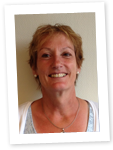Behind the scenes at SHM: Brenda Tuk (patient registration)
 Brenda Tuk has recently joined SHM and manages the patient registrations. Here, Brenda explains what her work involves and how she draws on her professional experience to help her in her work at SHM.
Brenda Tuk has recently joined SHM and manages the patient registrations. Here, Brenda explains what her work involves and how she draws on her professional experience to help her in her work at SHM.
Could you tell us a little about your background?
I have always done administrative work, primarily in the healthcare sector. I started at an immunology laboratory as medical secretary and then had various jobs, such as medical administrative assistant and medical secretary in outpatient clinics and a pathology lab. My previous job was in the commercial world, but healthcare is more my thing and I am glad to be working in this field again.
What exactly do you do at SHM?
I register HIV patients in the Netherlands in the SHM database. The information is registered in such a way that it cannot be directly traced back to the patients. The data are used by the analysis group at SHM and it is therefore very important that the information we received from throughout the country is properly recorded.
So the information arrives at SHM in an anonymous form?
Yes. That’s why my job is a separate position to that of data collectors, since they do have access to the patient’s details- this is necessary to be able to collect the data.
But are there still ‘tags’ to help you check which patient the data belongs to?
Yes there are, but I can’t trace these patient details back to a person. If it is unclear whether a patient is already registered with SHM, for example because there is a match with another patient’s information, I have to contact the data collector as this is the only person who can resolve such an issue.
What exactly do you look at when a new registration comes in?
I check whether the information is complete or whether a patient is already registered or is similar to someone who is already registered. The system usually lets me know if the information is incomplete or if there are similarities to a registered patient. However, it is important that I work carefully and remain alert. Mistakes in the registration process can skew the analysis results.
Does your work only involve registering and unregistering patients?
That’s what it primarily comes down to. Registering and unregistering patients in a registration database sounds far easier than it actually is. In fact it can be quite involved. For example, as the result of patients moving house, we regularly have complicated situations that have to be clarified.
The present registration database will also be replaced sometime this year by a new one. As a result, I am also involved in the current phase of development. You can read more about this in another article in this SHM newsletter.
In addition to the registrations, my task is to ensure that the data collectors can work with the data collection system, Oracle. I register the patients in Oracle and, in case of patients who move house, I transfer their data to the new HIV treatment centre. Here too, I have no access to any personal medical or private details.
In what way has your professional experience helped you in your work at SHM?
My broad experience with registration systems has been very useful here. Similarly, my medical background and extensive experience with administrative processes help me to deal with things I come up against in my work at SHM.
Because I switched jobs quite regularly, I have remained flexible and am able to quickly make a job my own, drawing on my experience. This was the case with the new registration database, for example; the system was already there when I arrived, but I have nonetheless been able to contribute to its development and testing. However, I am a little sorry that I couldn’t have been there right from the start.
The registration database is now in the test phase. What does this involve?
We are currently testing it from all angles: input, how this appears in the database, what data can we retrieve in reports etc. After this the necessary adjustments will be made.
So in a way you are still able to be part of the development of the database?
Yes and I’m glad about that and it also helps me to understand the system.
What part of your work at SHM do you enjoy most?
I enjoy going to work and find it fulfilling to be in the healthcare sector again. In terms of projects, the new registration database is right up my street, of course. My goal is to make this position my own within the possibilities it offers and to ensure that the registration process runs efficiently.
Will you be the contact person for the registration database?
I think I will be the main contact person, although there will be a back-up for when I am on leave. But overall I think I will be doing it alone. I have to say that I quite like this one-person position: I have my own responsibilities, but still have plenty of contact with colleagues.
